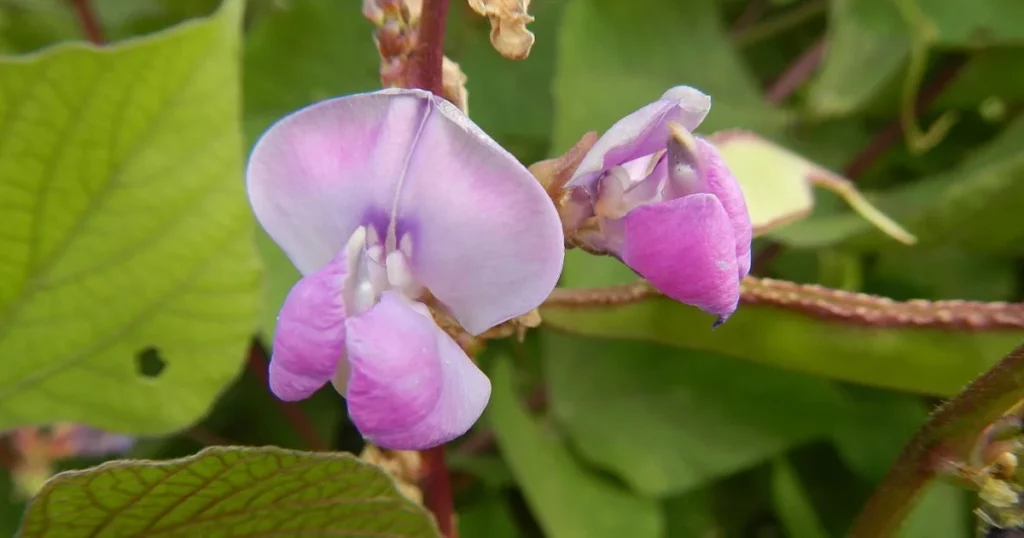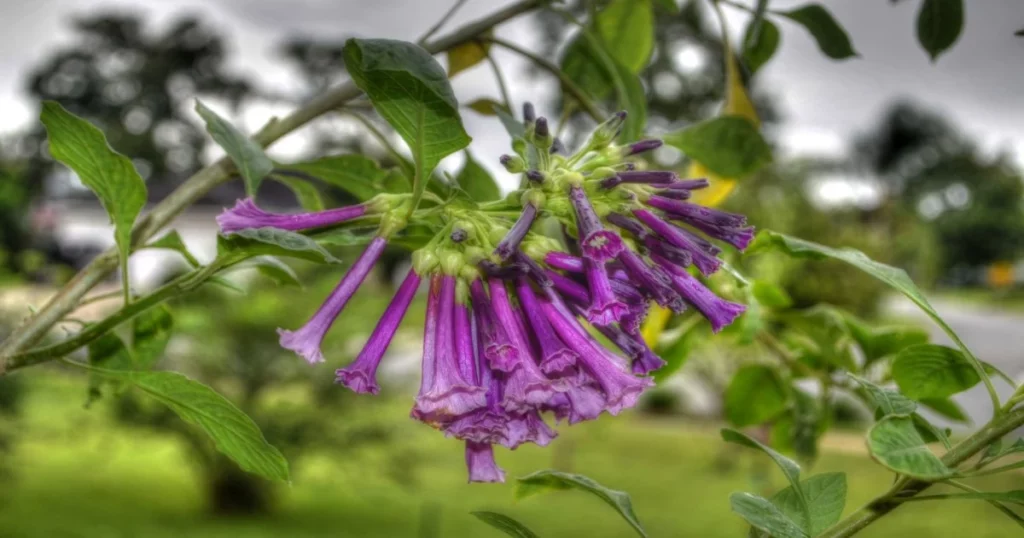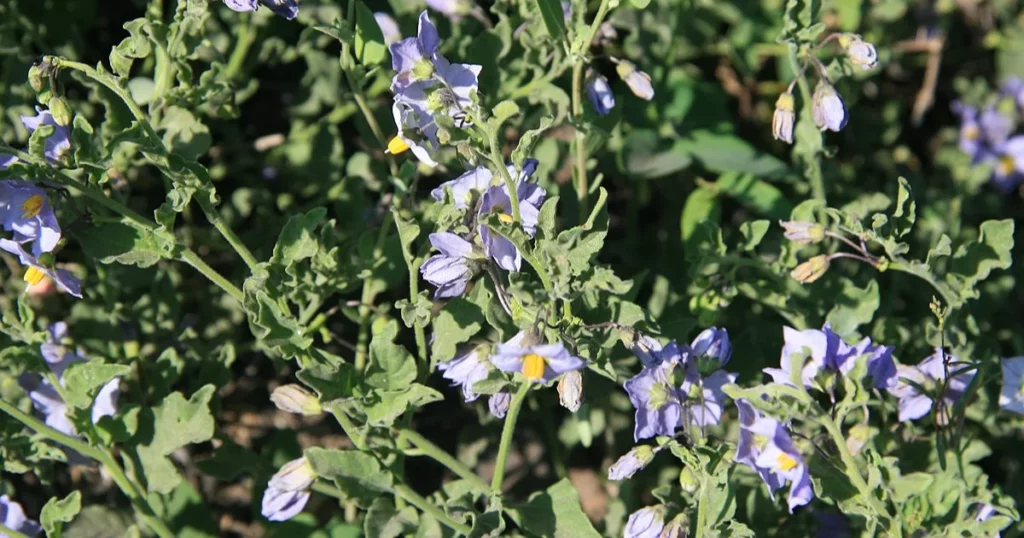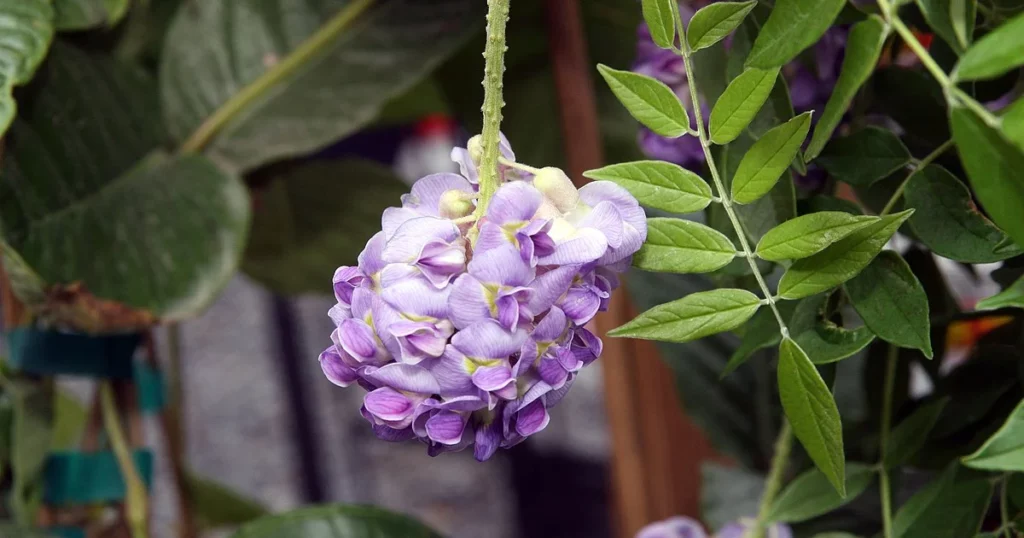12 Must-See Purple-Flowered Vines

Discover the enchanting world of vines with purple flowers, a captivating group of climbers that can transform any garden into a mesmerizing retreat.
These vines, known for their striking purple blooms, range from delicate lavender to deep plum shades, adding depth and vibrancy to garden spaces. Ideal for trellises, arbors, and fences, they create natural tapestries that enchant and intrigue.
To assist you in making the perfect choice, we’ve provided captivating images and detailed information on their planting and flowering seasons, ensuring you pick the ideal vine.
Discover 12 Stunning Purple-Flowered Vines and Choose the Right One for Your Garden:
1. Clematis (Clematis viticella)

Have you ever heard of the Clematis? It’s this amazing vine that’s famous for its stunning star-shaped flowers. You can find it originally from places like China, Japan, and Europe. What’s cool is that it can climb up to 10 to 15 feet tall and it’s pretty flexible about where it grows – it’s happy in both full sun and partial shade.
One of the neat things about Clematis is that it’s tough – it can handle colder climates, starting from zone 4 and up. So, if you’re in a place with some chilly winters, this might be a great addition to your garden.
The best part? Its prime time to shine is during the peak of summer when it bursts into these gorgeous purple blooms. And there are over 300 different kinds of Clematis out there, each with its own unique twist on those purple flowers.
2. Passion Flower (Passiflora ‘Amethyst’)

As you can see in the picture above, the ‘Amethyst’ Passion Flower is a sight to behold. Those purple flowers are just mesmerizing, aren’t they? Picture vibrant violet and magenta blooms adorning a vine that can stretch anywhere from 6 to 30 feet tall. It’s like nature’s own piece of art!
But here’s the thing, this vine isn’t just a pretty sight. It’s also got a practical side. Those beautiful flowers? They’re not just for show. They actually produce edible fruits! And get this, this vine is a real workhorse when it comes to blooming. It can churn out up to 60 blossoms a day! That’s some serious flower power, right?
Now, if you’re thinking of adding one to your garden, there are a few things to keep in mind. First off, this vine likes its sunshine, so make sure it gets plenty of it. Partial shade works too, but it thrives best under that warm sun. Oh, and it’s a bit picky about where it lives, preferring USDA zones 10 to 11.
When it comes to its home in the soil, the Passion Flower isn’t too demanding. Just make sure the soil is loose and well-drained. It’s not too fussy about pH levels either, ranging from mildly alkaline to mildly acidic.
So, if you’re looking to add a splash of vibrant color to your garden and maybe even enjoy some tasty fruits along the way, this vine with those stunning purple flowers might just be the perfect fit for you!
Also Read: Low-Maintenance Plants for Living Room
3. Purple Wreath Vine (Petrea volubilis)

Ah, the majestic Purple Wreath Vine, a gem from the heart of Central and South America, truly is a gardener’s delight. Imagine this tropical climber, gracefully ascending, reaching for the skies up to an impressive 40 feet! It’s a sight to behold when basking in the full embrace of the sun, thriving gloriously in the warmth.
Now, for those residing in USDA zones 10 to 11, you’re in luck. This vine is tailor-made for your gardens, ready to weave its magic. The real showstopper, however, is its remarkable inflorescences, clusters of violet-purple flowers that drape elegantly, creating a visual spectacle unlike any other.
As the calendar turns towards the late spring and early summer months, prepare yourself for an explosion of color. This vine doesn’t just bloom; it celebrates the season with fervor. And its foliage, oh, the rich dark green leaves are a perfect backdrop to the vibrant blossoms.
Caring for this beauty is a rewarding endeavor. It yearns for fertile, well-drained soil, a bed where it can lay its roots and flourish. Regular moisture is key – not too much, mind you, just enough to keep the soil pleasantly humid. With just a bit of tender care, the Purple Wreath Vine will transform your garden into a tropical paradise.
4. Hyacinth Bean Vine (Lablab purpureus)

Next, let me introduce you to a personal favorite of mine, the Hyacinth Bean Vine. This vigorous annual climber, my friend, is a true spectacle in any garden, reaching for the skies at an impressive 10 to 15 feet. It revels in the glory of the full sun, basking in its warmth to unfurl its beauty.
Hailing from the exotic lands of Africa and Asia, this vine is nothing short of a masterpiece with its enchanting pale purple bracts and the deep burgundy of its stems. It’s like having a piece of art right in your backyard, creating a mesmerizingly lush canvas that can transform any plain trellis or fence into a vibrant live painting.
Now, let me tell you about its growth – it’s like watching magic unfold right before your eyes! This plant doesn’t just grow; it leaps and bounds, making it a top pick for us gardeners eager to see instant transformations in our green spaces. But, a word of caution with its beans – a young one is a treat, but let them age, and they’re not so sweet, veering into toxic territory.
For those of you in search of a garden ally that’s swift in growth and non-invasive, all while parading those unique purple blossoms and foliage, the Hyacinth Bean Vine is your go-to. It’s a true gem that adds that special touch of intrigue and beauty to your garden haven.
5. Morning Glory (Ipomoea purpurea)

Dive into the captivating realm of the Morning Glory vine, a true spectacle with its trumpet-like blossoms that command attention in any garden. This versatile climber is quite the world traveler, comfortably settling in as a perennial in the balmy zones 9-11, and graciously adopting the role of an annual in cooler regions. With a penchant for basking in the sun’s full glory, it stretches upwards to a commendable 6 to 10 feet.
Now, the real magic unfolds each dawn when the vine’s vibrant purple flowers open up, revealing an exquisite star-shaped pattern, a daily marvel that gracefully concludes as the sun sets. It’s this ephemeral beauty that makes the Morning Glory a garden favorite.
Yet, beneath its stunning facade, the Morning Glory harbors a spirited nature. Its resilience to drought and propensity to self-seed make it a low-maintenance ally for the gardener. However, this same vigor requires a watchful eye to prevent it from overstepping its bounds and becoming invasive. It’s about striking the perfect balance, allowing it to spread its beauty without encroaching too far.
A note of caution: while the vine’s seeds add to its allure, they bear a hidden toxicity. It’s essential to keep them out of reach from the innocent curiosity of children and pets, ensuring the garden remains a place of joy and safety for everyone.
In the grand theatre of your garden, the Morning Glory vine plays a starring role, weaving a narrative of radiant beauty, resilience, and a dash of wild charm, all while demanding just a bit of guidance to ensure harmony in your green retreat.
Must Read: Vegetables You Can Grow Indoors in the Winter
6. Lavender Trumpet Vine (Clytostoma callistegioides)

Now, let’s talk about the Lavender Trumpet Vine, a true jewel in the garden with its enchanting trumpet-shaped blossoms that cast a soft purple spell. This perennial climber, hailing from the vibrant lands of Brazil, can soar to impressive heights of 15 to 20 feet, flourishing under the gentle caress of both full sun and the dappled light of partial shade. Its adaptability makes it a splendid fit for various garden nooks.
Remarkably hardy across zones 4 to 10, this vine demonstrates a vigorous zest for life, embracing a broad spectrum of climates with open arms. Its lush foliage unfurls rapidly, making it a prime candidate for adorning walls, fences, or trellises with a verdant cloak. Yet, this vigorous growth beckons for a gardener’s guiding hand through regular pruning, ensuring its beauty remains a blessing rather than becoming an unwitting encroachment.
Come blooming season, the Lavender Trumpet Vine weaves a pastel hue into the garden’s tapestry, endearing itself to those of us with a penchant for purple floral vignettes. Its presence in the landscape is not just a visual feast but a testament to the harmonious blend of vigor and grace, making it a cherished choice among garden enthusiasts eager to infuse their realms with a touch of lavender allure.
7. Purple Bell Vine (Rhodochiton atrosanguineum)

The Purple Bell Vine offers a unique and exotic addition to any garden with its bell-shaped, magenta-purple flowers and a central tube of extraordinary maroon color.
This soft perennial can be grown as an annual in colder climates, reaching 10 to 12 feet in height. It prefers full sun to partial shade, with a particular liking for afternoon shade, making it adaptable to various garden settings.
The Purple Bell Vine blooms from late spring to late fall, providing a long season of vibrant purple flowers that change to rose red after pollination, yet remain on the plant for weeks. Its heart-shaped leaves, with a hint of purple on their edges, complement the flowers, adding to the vine’s ornamental appeal.
This vine is an easy-to-grow, low-maintenance choice for adding a touch of exotic elegance and long-lasting color to informal garden designs, including exotic and temperate themes.
6. Bougainvillea (Bougainvillea spectabilis)

Bougainvillea, this vibrant vine, is a real showstopper with its brilliant purple hues, and it’s a true gem I often recommend to gardeners aiming to brighten up their green spaces. Don’t be fooled by its dainty white flowers; it’s the bold, colorful bracts that steal the show, mimicking a sea of purple blooms.
With the potential to stretch from 15 to a whopping 40 feet, it’s a sun worshipper’s dream and an excellent choice for those sunny spots with trellises or walls in your garden. Its blooming season is generously long, from the first whispers of spring right through to the fall, ensuring a continual feast for the eyes.
Just a heads up, though – Bougainvillea has a bit of a wild side in certain areas, known to spread its beauty a little too freely. It’s always smart to check in with local planting advice, something I always remind my fellow gardeners, to keep its vibrant spirit in check.
Also Read: China Doll Plant Care Tips, Propagation, Benefits, Problems
7. Purple Nightshade (Solanum xanti)

Purple Nightshade, a versatile gem from North America, could be a splendid addition to your garden. Whether you let it grow as a lush shrub or guide it to climb like a vine, it can reach up to an impressive 8 feet.
What’s fantastic about this plant is its adaptability to your garden’s light conditions, flourishing anywhere from the full glow of the sun to the serenity of full shade. It’s hardy in zones 7-10, making it a resilient choice for your green space.
The plant’s distinctive flared purple petals, cradling a bright yellow pistil, bring a unique ornamental touch to your garden. However, it’s vital to keep in mind that Purple Nightshade is not just a pretty face; it’s poisonous.
So, you’ll want to ensure it’s planted away from curious pets or little ones. On the upside, its resistance to deer can be a real boon for your garden, deterring those graceful grazers from turning your plants into their snack.
8. Twining Snapdragon (Antirrhinum kelloggii)

While the Twining Snapdragon might not be your conventional vine, it has a charming way of climbing, vine-like, which can bring a unique twist to areas in your garden that don’t have the usual supports for climbers. Originating from North America, this annual stands tall at 1 to 3 feet and is quite content in anything from the full embrace of the sun to the gentleness of partial shade.
What’s special about the Twining Snapdragon, and something you might find delightful, is its vibrant indigo or deep purple blossoms. They maintain that whimsical Snapdragon shape, adding a playful touch to your garden.
Its slender stems are quite the acrobats, capable of twining around other plants and surfaces. This makes it a versatile choice for weaving those lovely purple tones throughout different parts of your garden.
9. Wisteria (Wisteria sinensis)

Wisteria is truly a timeless vine that could transform your garden with its stunning waterfalls of fragrant, purple blossoms. As a deciduous perennial, it has the potential to stretch up to 30 feet or beyond, offering a dramatic flair to your arbors, pergolas, and trellises.
Hailing from China, the Wisteria sinensis variety loves basking in full sun and thrives in well-drained soil, with its most spectacular show of blooms appearing from late spring to early summer.
Its quick growth and sprawling nature make it a fantastic choice for you if you’re aiming to craft a breathtaking purple flower vine spectacle in your garden. However, it’s worth noting that Wisteria does call for some commitment on your part, needing regular pruning to keep its vigorous growth in check and prevent it from overstepping its bounds.
10. Jackmanii Clematis (Clematis ‘Jackmanii’)

The ‘Jackmanii’ Clematis might just be the standout star you’re looking for, with its large, velvety, deep purple flowers that are a sight to behold. This vine can gracefully ascend to heights of 10 to 12 feet, fitting perfectly into zones 4 through 8 in your garden. I
t has a unique preference, enjoying a spot where its roots can stay cool in the shade, while its foliage and blooms soak up the full sun to partial shade.
When mid to late summer rolls around, ‘Jackmanii’ bursts into a spectacular display of purple that can transform walls, fences, and trellises into natural artworks. It’s a variety that’s earned its popularity, not just for the visual splendor it brings but also for its straightforward care requirements and robust flowering performance.
Whether you’re just starting on your gardening journey or you bring years of experience, the ‘Jackmanii’ Clematis could be a delightful addition to your garden, offering beauty with minimal fuss.
Must Read: What Fruits Grow in 30 Days
11. Sweet Pea (Lathyrus odoratus)

Sweet Pea, an enchanting annual vine, could be just what your garden needs to add a touch of romance with its delightful, fragrant blossoms that come in a variety of colors, including lovely shades of purple.
It’s quite the climber, reaching up to 6 feet, and it flourishes in the cooler embrace of the garden, thriving under the gentle kiss of full sun to partial shade. When late spring to early summer rolls around, Sweet Peas put on a captivating show with their delicate, butterfly-like flowers, infusing any garden space with a whimsical charm.
This vine is a perfect match for your trellises, arches, and fences, allowing those fragrant blooms to be enjoyed up close. Sweet Peas do ask for a bit of support to reach their full potential, and a bit of your time spent deadheading will reward you with a continuous display of blooms throughout the season, keeping your garden lively and fragrant.
12. Amethyst Falls Wisteria (Wisteria frutescens ‘Amethyst Falls’)

The ‘Amethyst Falls’ Wisteria is a gem among vines, offering a more manageable twist on the classic Wisteria allure with its breathtaking, fragrant, purple blossoms. This variety, a kinder spirit from North America, won’t overstep its bounds, making it perfect for your smaller garden spaces or areas where room is at a premium. It stretches up to a respectable 15-20 feet, a modest stature in the Wisteria family, and happily settles into zones 5 through 9.
Come late spring to early summer, ‘Amethyst Falls’ puts on a spectacular show with its cascades of lavender-blue flowers, a sight to behold in any garden. It yearns for a sunny spot cradling well-drained soil yet impresses with its versatility, adapting to a variety of conditions.
Its compact size and genteel nature render it an ideal choice for your garden, allowing it to adorn arbors, trellises, and pergolas with its purple floral elegance, without the risk of it taking over your cherished outdoor sanctuary.
See Also: Best Trailing Plants for Hanging Baskets
Conclusion
As we wrap up this exploration of captivating climbing plants with purple flowers, I’m reminded of the joy and color these climbers have brought to my own garden. From the lush drapes of Wisteria to the intricate flowers of Clematis ‘Jackmanii’, each plant has its own story in my gardening journey. I hope sharing these personal favorites inspires you to add a touch of purple to your outdoor space, creating a serene and vibrant garden sanctuary.
I’m eager to hear about your gardening experiences as well. Have any of these purple-flowered climbers adorned your garden? Or do you have any tips or questions to share with our gardening community? Your insights and inquiries are warmly welcomed; let’s cultivate a shared space of growth and inspiration.
